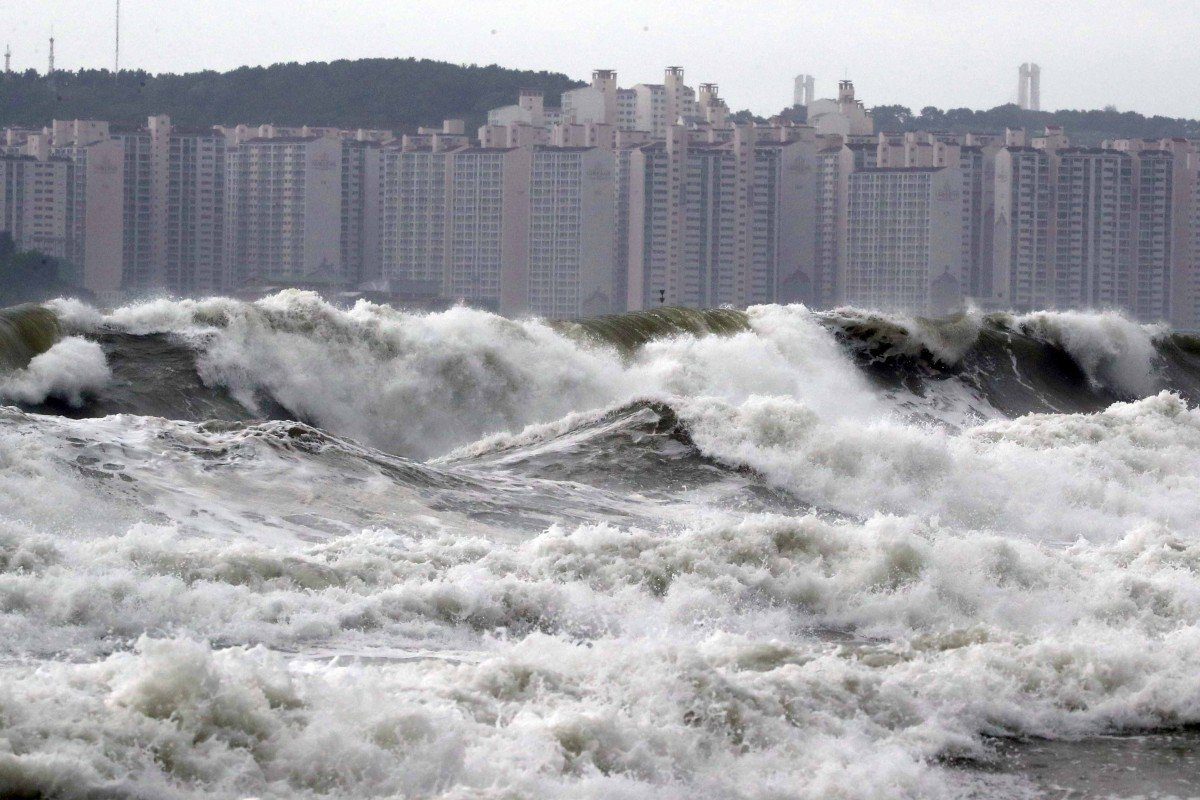
© AFPHigh waves batter a beach in the South Korean port city of Busan on Saturday.
A typhoon passed along
South Korea's coast on Saturday, toppling trees, grounding planes and causing at least three deaths before the storm made landfall in North Korea.
A 75-year-old woman in the central town of Boryeong was killed after strong winds from Typhoon Lingling blew her off her feet and crashed her into a wall 30 metres away, South Korea's Ministry of the Interior and Safety said. In the western city of Incheon a 39-year-old was killed after being crushed by a collapsed wall at a hospital car park. And a 61-year-old Chinese national died in the border town of Paju after being hit by a blown-off roof tile.
The South Korean government said at least 10 people were being treated for injuries, including an elderly couple from Boryeong who were injured after steel scaffolding collapsed over their home.
The storm knocked out power to more than 127,000 homes across the country, including on the southern island of Jeju, which was lashed by the typhoon overnight, the ministry said.
After hitting Jeju, the storm remained offshore as it moved up South Korea's west coast on Saturday morning before making landfall in
North Korea in the afternoon.
South Korea's weather agency said the storm was moving north at 49 kilometres per hour with winds of up to 133 kilometres per hour. Residents in the North Korean capital of Pyongyang were seen using umbrellas to shield themselves from wind and rain while struggling to walk through wet streets.
In South Korea, the storm toppled trees and streetlamps, blew signboards off buildings and damaged traffic signs across the mainland and Jeju. More than 120 flights were grounded at airports nationwide, while 38 people were forced to evacuate from their flooded homes in Gwangju, a city near Seoul.
Traffic to Incheon International Airport, one of Asia's largest transport hubs, was disrupted by the closure of its gateway bridge and a power failure at a commuter rail network that links the airport with Seoul.
Fire crews in Incheon responded to some 100 calls reporting typhoon-related damage, including destroyed walls, knocked-off signboards and fallen trees.
Ten cars were damaged in the southern town of Namwon when a roof plate blew off an apartment building and crashed into a car park. A similar incident in the eastern city of Wonju left five vehicles destroyed. A large spire was knocked off a church in a commercial district in Seoul.
National parks were closed as were southern ports on the mainland and major cross-sea bridges.
South Korea's weather agency has warned of flooding, landslides and structure damaged caused by strong rain and winds expected nationwide until early Sunday.
The storm could possibly inflict more serious damage as it passes through land in North Korea, an impoverished nation that for decades has struggled to deal with natural disasters.
North Korea's official Korean Central News Agency said leader
Kim Jong-un "urgently convened" an emergency meeting on Friday to discuss disaster prevention efforts and scolded government officials who he described as "helpless against the typhoon, unaware of its seriousness and seized with easy-going sentiment".
Kim called for his military to drive national efforts to minimise damage from the typhoon, which he said would be an "enormous struggle" that would require the entire country to step up, the report said.
North Korea, which suffers from severe food shortages, was paying "primary attention" to protect agricultural crops and prevent damage in dykes, dams and reservoirs, KCNA said. Officials were also moving residents in areas vulnerable to flooding and deploying "watchmen" to monitor bridges, buildings and houses.
AP
Reader Comments
to our Newsletter